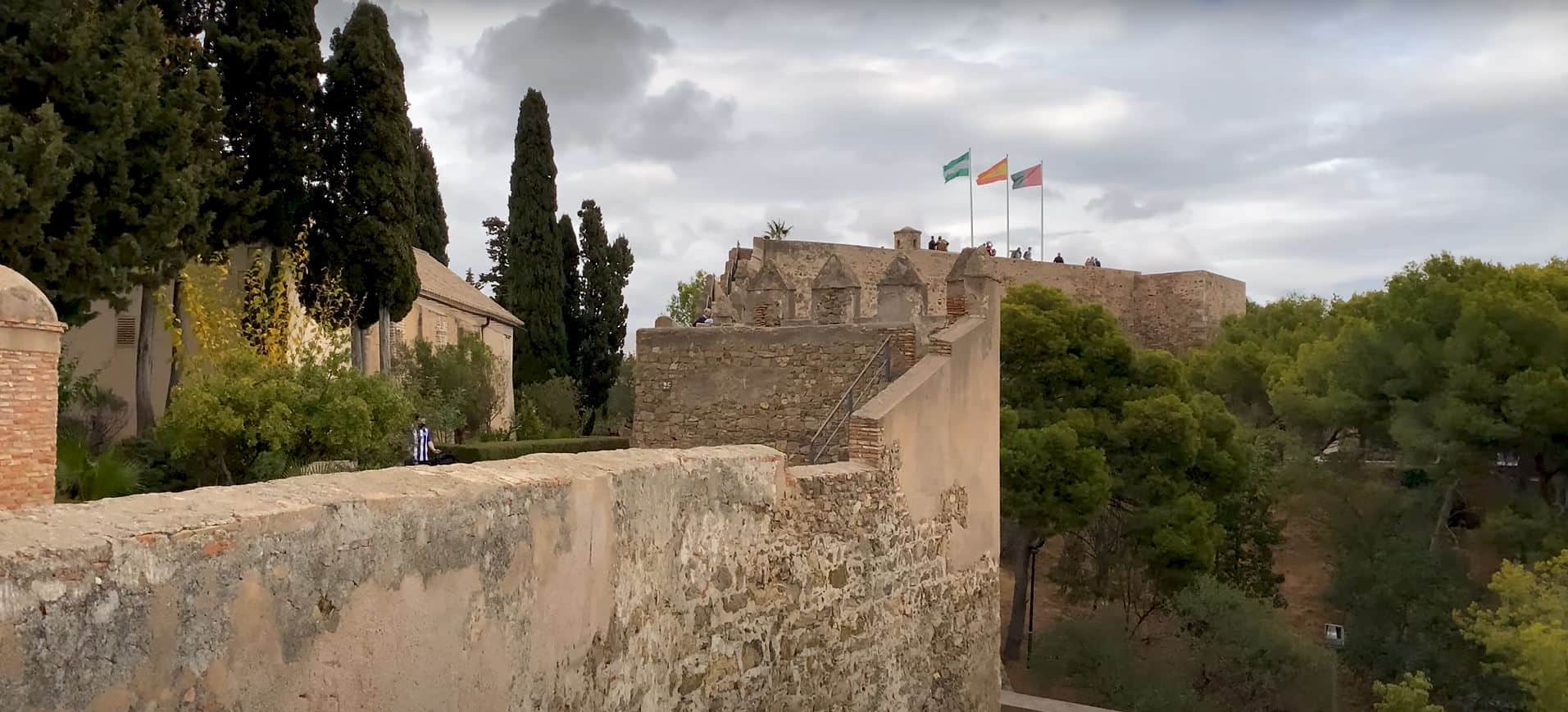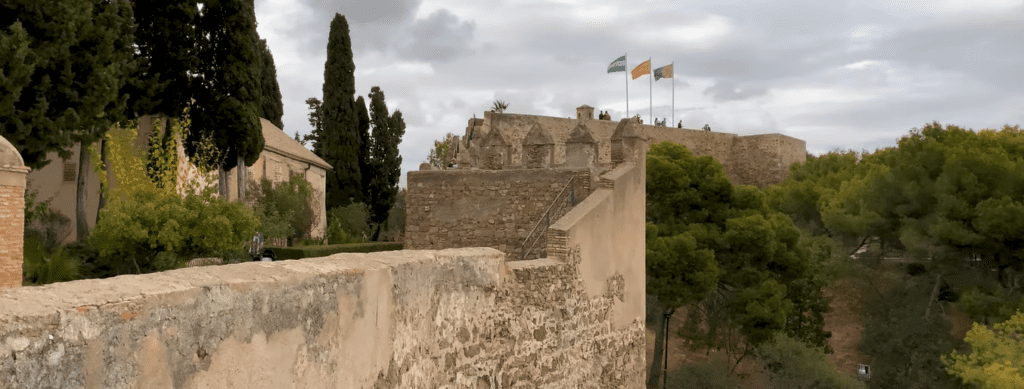The Gibralfaro Castle | Malaga, Spain

Updated On: March 21, 2024 by Ahmed Samir
The Gibralfaro Castle, one of Andalusia’s most recognizable relics, will give you a sense of the empire’s grandeur. Once you get inside, you will spot that the ceilings are also beautifully decorated with geometrical and Islamic patterns.
Perched atop Mount Gibralfaro overlooking the Mediterranean Sea, the stunning Gibralfaro Castle has been a focal point of Malaga, Spain, since the 14th century. This Moorish-era castle complex contains spectacular views, intricate stonework and lush gardens, providing a glimpse into Malaga’s unique multicultural history spanning centuries. Read our guide to visiting Gibralfaro Castle for everything you need to know to plan your visit, including tips for making the most of your time there.
History of The Gibralfaro Castle:
The Gibralfaro Castle has a rich and complex history that dates back to the 14th century. Originally built as a palace fortress by Yusuf I of Granada, the castle was intended to defend Málaga from Christian invaders during the Reconquista.
In the 15th century, Muhammad XII of Granada (also known as Boabdil) constructed a new fortified enclosure around Gibralfaro and connected it to the Alcazaba palace on the hill below. This complex design took advantage of the strategic position of the castle, allowing it to command views of Málaga and approaching enemies. Soldiers could also retreat uphill from the Alcazaba to Gibralfaro if under attack.
During the 1487 siege of Málaga, Gibralfaro was one of the last Moorish strongholds to fall to the Christian forces of Ferdinand and Isabella. After the conquest, the castle underwent extensive renovations, including the addition of thick double walls, ramparts, and bastions. These modifications transformed Gibralfaro into an impregnable fortress.
Gibralfaro continued to be used for military purposes for centuries. However, it was decommissioned in the late 18th century and fell into disrepair. It was not until the 20th century that the castle was restored and opened to the public. In 1925, Gibralfaro was designated a National Monument.
The Gibralfaro Castle is one of Málaga’s most popular tourist destinations today. Visitors can explore the castle’s many courtyards, towers, and ramparts and learn about its long and fascinating history.
Additional facts:
- The Gibralfaro Castle is named after the Arabic word “Jabal-al-Faro,” which means “Mountain of the Lighthouse.”
- The castle is on a hilltop overlooking Málaga, offering stunning views of the city and the Mediterranean Sea.
- Throughout history, the castle has been used as a military fortress, royal residence, prison, and military base.
- The castle has several interesting exhibits, including archaeological artefacts, military equipment, and Moorish art.
Description of the castle’s architecture

The Gibralfaro Castle is a complex structure with various architectural features that reflect its long and varied history. The castle walls are made of thick red brick and are topped with crenellations, alternating notches and merlons that allow archers and crossbowmen to fire on the enemy while being protected from their fire.
The castle has several towers, each with its unique purpose. The Torre del Homenaje’s tallest tower was used as a watchtower to defend the castle’s main entrance. The Torre Blanca was used as a lighthouse to signal to other Moorish fortresses. Other towers were used as storage facilities, barracks, and prisons.
The castle also has several courtyards, each with its unique character. The Patio de Armas was the central courtyard for training soldiers and parades. The Patio de los Naranjos was a beautiful garden with orange trees and a fountain. It was a place of relaxation and recreation for the castle’s inhabitants.
Discussion of the castle’s decorative elements
The Gibralfaro Castle is decorated with various tiles, stuccowork, and carvings. The tiles are primarily blue and white and depict geometric patterns and Moorish motifs. The stuccowork is elaborate and includes intricate carvings of plants and animals. The carvings on the castle walls depict scenes from Islamic history and mythology.
One impressive carving depicts the Prophet Muhammad receiving the Quran from the angel Gabriel. These decorative elements reflect the Moorish architectural tradition, known for its intricate geometric patterns, calligraphy, and elaborate stuccowork.
What to See at Gibralfaro Castle:
The sprawling Gibralfaro Castle complex contains several areas and structures to explore:
The Towers – Three 14th-century defensive towers have been restored – Patio de Armas, Torre de Cristo and Torre de la Villa. Wander through them to admire the intricate brickwork and vaulted ceilings. From the top, you can enjoy panoramic coastal views.
The Walls – Walk along the ramparts and climb the staircases to stroll atop the towering double walls. Gaze out over the sea and appreciate how strategic this vantage point was for spotting approaching enemies.
The Cisterns – An ingenious water storage system allowed the fortress to withstand sieges, with underground cisterns carved out of the limestone bedrock holding supplies.
The Gate – The sole entrance to Gibralfaro is through an imposing 18th-century gate featuring a drawbridge, carved symbols and the royal coat of arms above the archway.
Palace Ruins – Foundations and rooms from the original 14th-century Moorish palace are visible, giving a sense of the once-lavish accommodations.
The Gardens – The grounds are beautifully landscaped with terraces, fountains, groves of eucalyptus trees and fragrant flower beds to relax in.
The Museum – Housed in the former barracks, this small museum contains artefacts uncovered at the site, models, and audiovisual displays recounting Gibralfaro’s history.
Tips for Visiting Gibralfaro Castle:
- Give yourself 2-3 hours to fully explore the expansive site and museum relaxedly.
- Arrive early in the morning or late afternoon to avoid the midday heat and larger crowds. Sunset is a particularly atmospheric time for photographs.
- Bring water – there is no drinking fountain onsite.
- Wear comfortable shoes suitable for walking on uneven stone surfaces.
- Take care of children near unfenced edges. Most areas have railings but supervise closely.
Getting to Gibralfaro Castle:
Gibralfaro Castle is on Mount Gibralfaro, just above Malaga’s city centre. While the views from the top are magnificent, climbing a moderately steep hill is required. Visitors have a few options to reach the entrance:
- Walk uphill from the Alcazaba – well-marked pedestrian routes wind up the hillside from the lower fortress, taking 30-60 minutes. Not ideal in hot weather.
- Bus #35 runs from the city centre directly to the Gibralfaro ticket booth. Look for the “Castillo de Gibralfaro” stop [9].
- Taxi from the city centre takes 5-10 minutes. Specify the Parador hotel so you can reach the castle entrance easily.
- Drive and park in the small lot by the Parador Hotel next to the castle (paid parking).
FAQ About Visiting Gibralfaro Castle:
How much are tickets to Gibralfaro Castle?
- Tickets are €5.50 for adults, €3.50 for reduced rate, and free for children under 12. Combined tickets with the Alcazaba are available for €11.
What are the opening hours?
- Open daily from 9:00 am to 8:00 pm, with the last entrance at 7:30 pm in summer and 6:30 pm in winter [11].
Can you take photos inside?
- Yes, photography is permitted throughout the site for personal use. Tripods are not allowed.
Is there a cafe or food available?
- There is no cafe onsite, but the Parador Hotel next door has a restaurant with incredible views. Bring your snacks and water.
Is the castle wheelchair accessible?
- Gibralfaro has some accessibility features, but the steep terrain and spiral staircases make it challenging for wheelchairs. Contact ahead about requirements.
Other Top Sights in Malaga:
While you’re in Malaga, make time to also visit these highlights near Gibralfaro Castle:
- The Alcazaba – Malaga’s original 11th-century Moorish palace fortress on the hill below Gibralfaro. Linked by a walled passageway.
- Malaga Cathedral – Known as ‘La Manquita’ for its unfinished tower, this impressive 16th-century Renaissance cathedral features ornate decor.
- Roman Theatre – Excavated antiquities site dating to the 1st century BC with an attractive free museum.
- Pablo Picasso Museum – Located in the artist’s place of birth, this compelling museum houses many of his early works.
- Malagueta Beach – Relax on Malaga’s top beach with 2km of golden sand and ample amenities—just 15 minutes from the city centre.






